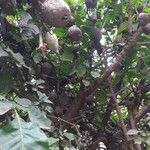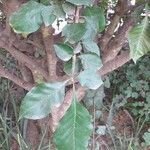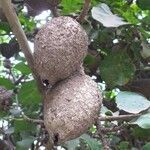A shrub or small spreading tree. It grows to 7 m high. The bark is grey or yellowish-brown and smooth. The small branches occur in rings or 3 at right angles to the branches. They are covered with rusty coloured powder. The leaves are opposite or in rings of 3. They are crowded near the ends of small branches. They are oblong and 13 cm long by 8 cm wide. They are yellowish-green to shiny dark green above. They are paler underneath. There are short hairs on both surfaces. The edges of the leaf is wavy. The flowers are white but turn yellow with age. They are 4 cm across. They have a tube up to 4.5 cm long. The fruit is oval and 5 cm long by 3.5 cm wide. They are finely velvety. They are yellowish-brown when mature. There is the remains of the calyx lobes at the end.
Leaves extremely variable, arranged ternately at the ends of short ternate shoots; blades (0.7)4–18(27) × (0.7)2–11.5 cm, oblanceolate to obovate-elliptic or oblong-obovate, usually ± rounded at the apex, less often acute, very gradually elongate-cuneate at the base sometimes for over half the length or sometimes rounded, (never of the distinct short rounded obovate-cuneate shape of the next species and distinctly thicker than in that species and with coarser more prominent venation), glabrous or sparsely to quite densely shortly scabrid-pubescent; hairy domatia usually present; petiole 0–5 mm long; stipules 2–4 mm long, broadly ovate, glabrous or pubescent, arranged in the form of a cup at the base of the calyx tube at flowering nodes.
Shrub or small tree 1–6 m tall, often stunted in appearance; bole up to 20 cm wide and crown often broad, either entirely glabrous (except for style and domatia) or with stems, leaves and flowers variously pubescent or scabrid, sometimes only youngest parts of stem and upper stipules pubescent; bark smooth to rather rough, yellow-green or grey sometimes breaking down on the shoots to form a yellowish or reddish powder; branches often short and thick, arranged ternately.
Fruit yellowish to reddish-brown, 3.5–7.5(8) × 1.6–3.3(5.6) cm, narrowly to broadly oblong-ellipsoid or ellipsoid, less often subglobose or narrowly fusiform, with wall fibrous or woody 5–10 mm thick, finely striate and obscurely lenticellate but essentially smooth and without coarse ribs (although some ribbing has been indicated for young fruits in collectors' drawings).
Calyx tube 4–10 mm long, glabrous to rather scabrid-pubescent; limb-tube 6–15 mm long, ± truncate or with 6–9(12) lobes which are very variable, 2–15 × 0.5–4 mm, linear, narrowly oblong or elliptic to distinctly spathulate, acute or obtuse, occasionally 2 joined together for half their length.
Corolla, white at first, later bright then dull-yellow; tube (2.5)4.5–11 × 1–2.5 cm, cylindric, glabrous to appressed pilose but rarely densely hairy; lobes 6–9, 20–55 × 10–25 mm, elliptic to oblong-elliptic, mostly glabrous.
Seeds chestnut-coloured, 3.5–4(4.5) × 2–3 mm, flattened ellipsoid, finely reticulate-shagreened.
Pollen presenter greenish-yellow, 5 mm long, fluted, 5–9-lobed, shortly exserted.
Flowers fragrant, white, opening at night, turning yellow next day
Anthers about 15 mm long, included in the tube.
Fruits fibrous, grey-green, long-persistent
A savanna shrub, 5-15 ft. high




